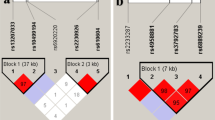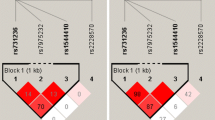Abstract
Previous studies have found that the Fc receptor-like (FCRL) molecule, involved in controlling B cell signaling, may contribute to the autoimmune disease process. Many studies have reported the relation of FCRL gene family with SLE and RA. We hypothesized that FCRL4 may be a key gene for ankylosing spondylitis (AS) development. To test this hypothesis, we screened FCRL4 polymorphisms in the Chinese Han population. Five tag single nucleotide polymorphisms (SNPs), including rs14335, rs849826, rs10489674, rs2778003, and rs2777963, were selected. Using a case–control study, five tag SNPs, which captured the majority of known common variation within FCRL4 gene, were selected and genotyped by Multiplex Snapshot technique. We analyzed 299 patients and 300 controls from China. The genotype analysis demonstrated that one of the FCRL4 tag SNPs rs2777963 TT genotype may be a risk factor of AS (χ 2 = 7.374, p = 0.024). The haplotype analysis indicated that there were no significant differences between AS cases and controls. Patients with AS who had rs14335 AA genotype had a significantly declined visual analogue scale patient's global assessment scores compared to those with the GG genotype (31.21 ± 26.25 vs 40.54 ± 25.40, p = 0.035) and GA genotype (38.29 ± 24.94 vs 40.54 ± 25.40, p = 0.044), and in locus rs10489674, TT genotype had significantly increased Bath Ankylosing Spondylitis Disease Activity Index scores compared to those with the CC genotype (4.73 ± 2.43 vs 3.15 ± 1.61, p = 0.003) and CT genotype (4.73 ± 2.43 vs 2.97 ± 1.71, p = 0.001). The FCRL4 polymorphisms may play an important role in the susceptibility and severity of AS in the Chinese Han population.
Similar content being viewed by others
References
Haywood KL, Garratt AM, Jordan K, Dziedzic K, Dawes PT (2004) Spinal mobility in ankylosing spondylitis: reliability, validity and responsiveness. Rheumatology (Oxford) 43(6):750–757
Braun J, Bollow M, Remlinger G et al (1998) Prevalence of spondylarthropathies in HLA-B27 positive and negative blood donors. Arthritis Rheum 41(1):58–67
Zeng Q, Chen R, Darmawan J et al (2008) Rheumatic diseases in China. Arthritis Res Ther 10(1):R17
Thomas GP, Brown MA (2010) Genetics and genomics of ankylosing spondylitis. Immunol Rev 233(1):162–180
Young HL, Young HR, Seong JC, Jong DJ, Gwan GS (2005) Ankylosing spondylitis susceptibility loci defined by genome-search meta analysis. J Hum Genet 50(9):453
Reveille JD, Sims AM, Danoy P et al (2010) Genome-wide association study of ankylosing spondylitis identifies non-MHC susceptibility loci. Nat Genet 42(2):123–127
Evans DM, Spencer CC, Pointon JJ et al (2011) Interaction between ERAP1 and HLA-B27 in ankylosing spondylitis implicates peptide handling in the mechanism for HLA-B27 in disease susceptibility. Nat Genet 43(8):761–767
Sánchez A, Szczypiorska M, Juanola X et al (2010) Association of the intergenic single-nucleotide polymorphism rs10865331 (2p15) with ankylosing spondylitis in a Spanish population. J Rheumatol 37(11):2345–2347
Ge R, Pan F, Liao F et al (2011) Analysis on the interaction between IL-1 F7 gene and environmental factors on patients with ankylosing spondylitis: a case-only study. Mol Biol Rep 38(4):2281–2284
Davis RS (2007) Fc receptor-like molecules. Annu Rev Immunol 25:525–560
Ehrhardt GR, Leu CM, Zhang S et al (2007) Fc receptor-like proteins (FCRL): immunomodulators of B cell function. Adv Exp Med Biol 596:155–162
Davis RS, Dennis G Jr, Odom MR et al (2002) Fc receptor homologs: newest members of a remarkably diverse Fc receptor gene family. Immunol Rev 90:123–136
Kochi Y, Yamada R, Suzuki A et al (2005) A functional variant in FCRL3, encoding Fc receptor-like 3, is associated with rheumatoid arthritis and several autoimmunities. Nat Genet 37(5):478–485
Ikari K, Momohara S, Nakamura T et al (2006) Supportive evidence for a genetic association of the FCRL3 promoter polymorphism with rheumatoid arthritis. Ann Rheum Dis 65(5):671
Newman WG, Zhang Q, Liu X et al (2006) Rheumatoid arthritis association with the FCRL3-169C polymorphism is restricted to PTPN22 1858T-homozygous individuals in a Canadian population. Arthritis Rheum 54(12):3820–3827
Hu X, Chang M, Saiki RK et al (2006) The functional -169T/C single-nucleotide polymorphism in FCRL3 is not associated with rheumatoid arthritis in white North Americans. Arthritis Rheum 54(3):1022
Xia Guo, Pan Faming, Liao Fangfang et al (2010) No significant association between Fc receptor-like 3 gene polymorphisms and human leukocyte antigen-B27 positive ankylosing spondylitis in Han Chinese population. Mol Biol Rep 37(1):297–300
Tang X, Pan F, Xia G et al (2009) A single-nucleotide polymorphism marker within the FCRL5 gene and HLA-B27 positive Han Chinese ankylosing spondylitis patients. Tissue Antigens 74(4):314–316
Van der Linden S, Valkenburg HA, Cats A (1984) Evaluation of diagnostic criteria for ankylosing spondylitis. A proposal for modification of the New York criteria. Arthritis Rheum 27(4):361–368
Wei JC, Wong RH, Huang JH, Yu CT, Chou CT, Jan MS et al (2007) Evaluation of internal consistency and re-test reliability of Bath ankylosing spondylitis indices in a large cohort of adult andjuvenile spondylitis patients in Taiwan. Clin Rheumatol 26:1685–1691
Salmon JE, Pricop L (2001) Human receptors for immunoglobulin G: key elements in the pathogenesis of rheumatic disease. Arthritsi Rheum 44(4):739–750
Li Yi, Pui Y, Lee Erinn S, Kellner ES et al (2010) Monocyte surface expression of Fcγ receptor RI (CD64), a biomarker reflecting type-I interferon levels in systemic lupus erythematosus. Arthritis Research & Therapy 12(3):R90
Kono H, Kyogoku C, Suzuki T et al (2005) Fcgamma RIIB Ile232Thr transmembrane polymorphism associated with human systemic lupus erythematosus decreases affinity to lipid rafts and attenuates inhibitory effects on B cell receptor signaling. Hum Mol Genet 14(19):2881–2892
Hong CH, Lee JS, Lee HS, Bae SC, Yoo DH (2005) The association between fcgammaR IIIB polymorphisms and systemic lupus erythematosus in Korea. Lupus 14(5):346–350
Nimmerjahn F, Ravetch JV (2008) Fc gamma receptors as regulators of immune responses. Nat Rev Immunol 8(1):34–47
Chistiakov DA, Chistiakov AP (2007) Is FCRL3 a new general autoimmunity gene? Hum Immunol 68(5):375–383
Khan MA (2009) Ankylosing spondylitis. Oxford University Press, New York, pp 1–147
Brown MA, Laval SH, Brophy S, Calin A (2000) Recurrence risk modeling of the genetic susceptibility to ankylosing spondylitis. Ann Rheum Dis 59(11):883–886
Brown MA, Kennedy LG, MacGregor AJ et al (1997) Susceptibility to ankylosing spondylitis in twins: the role of genes, HLA, and the environment. Arthritis Rheum 40(10):1823–1828
Acknowledgments
We thank Shanghai Genesky Bio-Tech Co., Ltd. (www.geneskybiotech.com), for valuable help with the test of SNPs. We also thank all patients and controls who provided the DNA and information necessary for this study.
Funding
This work was supported by grants from the National Natural Science Foundation of China (30771849,30972530) and Natural Science Foundation of Anhui Province (090413133).
Disclosures
None.
Author information
Authors and Affiliations
Corresponding author
Additional information
Zhen Zeng and Zhenhua Duan contributed equally to this work and should be considered co-first authors.
Rights and permissions
About this article
Cite this article
Zeng, Z., Duan, Z., Zhang, T. et al. Association of FCRL4 polymorphisms on disease susceptibility and severity of ankylosing spondylitis in Chinese Han population. Clin Rheumatol 31, 1449–1454 (2012). https://doi.org/10.1007/s10067-012-2028-y
Received:
Revised:
Accepted:
Published:
Issue Date:
DOI: https://doi.org/10.1007/s10067-012-2028-y




